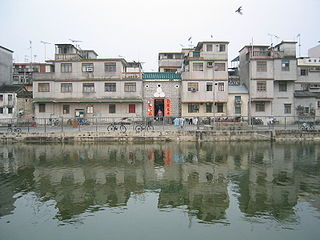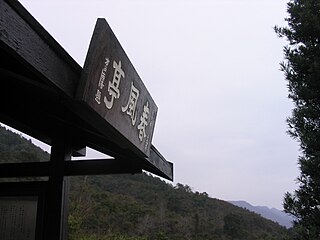
The Junkers Ju 52/3m is a transport aircraft that was designed and manufactured by German aviation company Junkers. First introduced during 1930 as a civilian airliner, it was adapted into a military transport aircraft by Germany's Nazi regime, who exercised power over the company for its war efforts, over the objections of the company's founder Hugo Junkers.

Kai Tak Airport was an international airport of Hong Kong from 1925 until 1998. Officially known as Hong Kong International Airport from 1954 to 6 July 1998, it is often referred to as Hong Kong International Airport, Kai Tak, or simply Kai Tak and Kai Tak International Airport, to distinguish it from its successor, Chek Lap Kok International Airport, built on reclaimed and levelled land around the islands of Chek Lap Kok and Lam Chau, 30 kilometres (19 mi) to the west.

China Airlines Flight 642 was a flight that crashed at Hong Kong International Airport on 22 August 1999. It was operating from Bangkok to Taipei with a stopover in Hong Kong.
MIAT Mongolian Airlines is the state-owned national airline of Mongolia, headquartered in the MIAT Building in the country's capital of Ulaanbaatar. The airline operates scheduled services from its base at Chinggis Khaan International Airport in Sergelen, near Ulaanbaatar.

Sheung Shui is an area in the New Territories, Hong Kong. Sheung Shui Town, a part of this area, is part of the Fanling–Sheung Shui New Town in the North District of Hong Kong. Fanling Town is to its southeast.

Fanling Wai is a village in Fanling, North District, Hong Kong, built by the Pang (彭) Clan. It is composed of a walled village and its two extensions: Ching Wai or Chung Wai – the only walled hamlet of Fanling Wai and also the first hamlet to be built, Pak Wai, and Nam Wai.

Fanling-Sheung Shui New Town was developed from the traditional market towns and villages around Fanling and Sheung Shui, within the present-day North District in the New Territories of Hong Kong. It was primarily developed in the mid 1980s. Connecting Fanling and Sheung Shui is an U-shaped main road called Ma Sik Road.

Fanling Highway is a part of Route 9 in Hong Kong. It connects the new town of Tai Po and San Tin Highway, passing through Sheung Shui and Fanling on its way. The three lane expressway was constructed between 1983 and 1987.
Tai Po Road is the second longest road in Hong Kong. It spans from Sham Shui Po in Kowloon to Tai Po in the New Territories of Hong Kong. Initially, the road was named Frontier Road.

Fanling Lodge is an official residence of the Chief Executive of Hong Kong, which serves as a country house and occasionally hosts official functions. Built in 1934 as a summer residence for the then Governor of Hong Kong, Fanling Lodge was granted a Grade I historic building status in 2014, amid concerns about its inclusion within a new town development plan.

Ta Kwu Ling is an area in the North District, New Territories, Hong Kong, located northeast of Sheung Shui, close to the border with mainland China and south to Liantang Subdistrict in Shenzhen.

As of October 2024, a total of 64 Boeing 747 aircraft, or just above 4% of the total number of 747s built, first flown commercially in 1970, have been involved in accidents and incidents resulting in a hull loss, meaning that the aircraft was either destroyed or damaged beyond economical repair. Of the 64 Boeing 747 aircraft losses, 32 resulted in no loss of life; in one, a hostage was murdered; and in one, a terrorist died.

The 1996 Pat Sin Leng wildfire took place in Pat Sin Leng, Tai Po, New Territories, Hong Kong on 10 February, 1996 (Saturday). It was the worst wildfire in local history. The disaster killed three students and two teachers at the Hong Kong Chinese Women's Club Fung Yiu King Memorial Secondary School and injured a further 13 students.

The Former Fanling Magistracy is located at No. 302 Jockey Club Road in Fanling, Hong Kong.
Fanling Airstrip was a military airstrip in the race course, Fanling, New Territories, Hong Kong.
John Cecil Macgown was a Scottish doctor in Hong Kong and member of the sanitary board.

Eurasia Aviation Corporation was a Chinese airline headquartered in Shanghai. The company had a Sino-German joint-venture with Deutsche Luft Hansa. Eurasia, classified as a state-owned airline by the Ministry of Communications of China, operated the Junkers W33 and, later, the three-engined Junkers Ju 52.The main fleet base was Hong Kong. When the Japanese began occupying portions of China in the late 1930s, the airline encountered difficulty.












